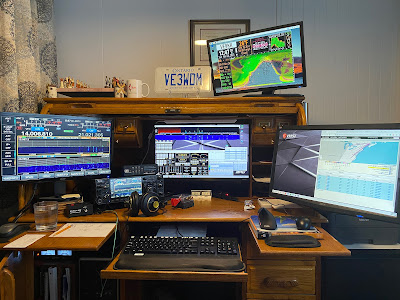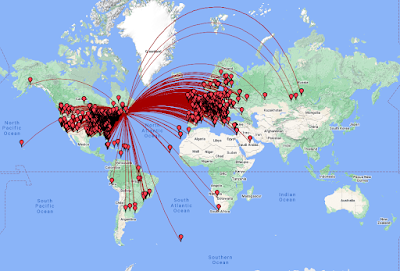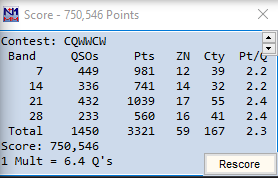 Parks on the air
Parks on the air
I had the opportunity to get on the radio this afternoon and at the same time, I had called up the DX Heat cluster on my PC to see what was happening on the bands. I noticed a few POTA (Parks on the Air) stations being spotted and I know of a POTA site that gave more info regarding the activations. I was shocked that in all of 10 minutes, I made 3 contacts. From reading my blog roll Parks on the Air and Summits on the Air are very popular. All these contacts I made were CW but SSB is very popular as well. There were more that I heard but was unable to make contact with as they had a pileup and their signal slowly faded away. I give these ops lots of credit, they pick up and go, have a minimal setup and its very cold this time of year as well.
Mike Weir, VE9KK, is a regular contributor to AmateurRadio.com and writes from New Brunswick, Canada. Contact him at [email protected].
 LHS Episode #523: Computing in the Clouds
LHS Episode #523: Computing in the Clouds
Hello and welcome to the 523rd installment of Linux in the Ham Shack. In this short topics episode, the hosts discuss the FCC removing symbol rate limitations, the ongoing WRC-23, Canonical MicroCloud, Ubuntu Budgie, Wayland and much more. Thanks for listening and have a great week.
73 de The LHS Crew
Russ Woodman, K5TUX, co-hosts the Linux in the Ham Shack podcast which is available for download in both MP3 and OGG audio format. Contact him at [email protected].
 VE9KK the world of CW 2023-11-27 18:05:00
VE9KK the world of CW 2023-11-27 18:05:00
 |
| My setup and the VE3WDM is my lic plate from Ontario |
This past weekend I was busy with the CQ World Wide CW contest...go figure! The solar weather was not looking good and for most of Saturday, the Kp index was around 6 and for a short time moved to 7. I was shocked the conditions were still decent. On Sunday the Kp index fell to 2-3 which also gave better conditions. I entered as low power (100 watts), all band and unassisted meaning I did not use QSO finding assistance. The bands I operated were limited to my antenna the Hustler 4BTV which meant that was 40,20,15 and 10m.
 |
| Spot in the middle of the Ocean is code garble SN70 I put zero and not the letter O |
Some of my highlights were getting a call from fellow blogger Bas PE4BAS, KH7L and V51YJ. I think because of the conditions solar weather wise it limited me from Southeast Asia. I did spend a lot of time in the operating chair and toward the end of the contest I started to get what I call "code garble". I heard a call but it just did not register, I heard a call but entered numbers or letters on the keyboard that had nothing to do with the call and so on. For example, numerous time I had a call starting 9A call me and every time I entered 0A. I kept having to correct it and that meant time and good old 9A wondered what I was up too. I ended up pulling the plug about an hour before the contest ended.
My best hourly contact rates were in the 130's and at the low-end 50's. I have been practising handling pileups using N1MM logger. You can set it up to give you pileup simulations. Not that I am a big gun but when you get spotted on the cluster things can get a bit hairy at times.
 |
| The final results |
During the contest 99% of the time I was calling "CQ contest" or running as it is called. My speed was 32-34 wpm. I find if your calling at 32 wpm you get replies at 25-36 wpm. When calling at 34wpm sometimes the comebacks can be very fast and mistakes happen. In this contest, the exchange is 599 (signal report) and CQ zone and that is filled in by the contest program. This means when your calling CQ contest you can go a bit faster as most slower callers most likely found your call on the cluster. When a serial number is involved a lot of contest stations slow down the serial number part of the exchange.
Overall it was a great contest and I look forward to it again next year. The next contest I am looking at is the RAC Canadian Winter contest in December.
Mike Weir, VE9KK, is a regular contributor to AmateurRadio.com and writes from New Brunswick, Canada. Contact him at [email protected].
 Amateur Radio Weekly – Issue 308
Amateur Radio Weekly – Issue 308
Scientists uncover aurora-like radio emission above a sunspot
These sunspot aurora emissions occur at frequencies ranging from hundreds of thousands of kHz to roughly 1 million kHz.
New Jersey Institute of Technology
SKYWARN Recognition Day is ready to go
The 2023 SKYWARN Recognition Day is December 2 from 0000z to 2400z.
ARRL
Will AI help us have more fun with Amateur Radio?
Your personal agent could monitor your club’s 2-meter repeater and notify you when your friends are on the air.
KB6NU
Amateur Radio accounts for 17% of Icom’s business
Icom released a document titled Medium Term Business Plan 2026.
EI7GL
What’s up with NVIS?
I was amazed that I sent and received a 59 signal report from an antenna that was only about 6 feet off the ground.
KK4Z
Cubesats: How an accidental standard launched a new space age
NASA was initially reluctant to embrace the small form factor.
Aviation Weekly
Cheap & cheerful telescopic SPOTA antenna
This is a handy standby antenna, or for holiday activations, but bring your tuner along.
QRPer
NASA launches Spot the Station app
Notifications each time the station passes over your location.
Amateur Radio Daily
Video
K9DP Broadcast Interference Filter 2.0
Field tested with a Xiegu G90.
W6IWN
How to build a mini HF loading coil
No need for a tuner.
Mr. MuD’s Radio Time VA5MuD
The OMs on QRZ said this won’t work
You can’t make QSOs with a wire that low to the ground. Boy-howdy were they wrong.
N7KOM
Get Amateur Radio Weekly in your inbox.
Sign-up here
Amateur Radio Weekly is curated by Cale Mooth K4HCK. Sign up free to receive ham radio's most relevant news, projects, technology and events by e-mail each week at http://www.hamweekly.com.
 Chances like this only come now and then……….
Chances like this only come now and then……….
 |
| The bands will come alive |
This weekend is the running of the CQ World Wide DX CW contest that runs for the entire weekend. Now those of you who are not into contesting then it's off the SSB portion, digi portion or the WARC band. But you don't have to be a contesting nut like me to be excited about this contest. This is a chance to find and make contact with some very decent DX. It will give you a chance to line your DXCC pockets, work all states award, work all zones award, place your rig in QRP or QRPp power and see how many miles per watt you can do and the list goes on. Not too great at CW you say, well there are some very decent code reader software out there that also send code as well. Chances like this only come now and then.
As for me I am going to be for the weekend and hope to do well and have a lot of fun while I am at it. Cheers and have a good weekend for those in the U.S. Happy Thanksgiving!
Mike Weir, VE9KK, is a regular contributor to AmateurRadio.com and writes from New Brunswick, Canada. Contact him at [email protected].
 The morning MST mini contest
The morning MST mini contest
Each Monday morning at 1300Z and 1900z I take part in the 1-hour medium-speed CW contest or MST as it is called. Medium speed is 25wpm or less and the exchange is your name and progressive contact number or serial number as they call it in contesting. During the mini contest this morning I was calling "CQ MST" and as always I also have loaded on my PC screen the reverse beacon network website as seen in the picture above. This allows me to see how my signal of 100 watts is getting out. This morning as I was calling on 20m I was shocked to see my signal strength into ZL4YL New Zealand and MM0ZBH Scotland.
Mike Weir, VE9KK, is a regular contributor to AmateurRadio.com and writes from New Brunswick, Canada. Contact him at [email protected].
 Taking the side road……
Taking the side road……
This weekend the LZ dx contest was up and running, I have never taken part in this contest and I was pleasantly surprised by the amount of activity. It's a 24-hour contest that started at 8 am out my way and it gave me a nice workout for the upcoming weekend for the CQ World Wide DX CW contest. I took part for about a total of 4 hours and made 120 contacts for a score of 13,110.
Midway into the contest I was taken down a side road for a pleasant surprise. At some point on Saturday afternoon calling CQ contest was slowing down on 20m. I decided to make a left turn and head down the 10m side road. There were very few LZ contesters there but I did notice a commotion on the waterfall. When I went to investigate it was H44WA DXpedition in the Soloman islands calling CQ North America (CQ NA) and he was all alone. I put the Icom 7610 in split and dual mode (hearing both VFOA and VFOB) and made the mental change from CW contesting to CW DXpedition. After a few short tries, I was in the log. I was glad I made a left turn and took a side road from the contest.
Mike Weir, VE9KK, is a regular contributor to AmateurRadio.com and writes from New Brunswick, Canada. Contact him at [email protected].

















